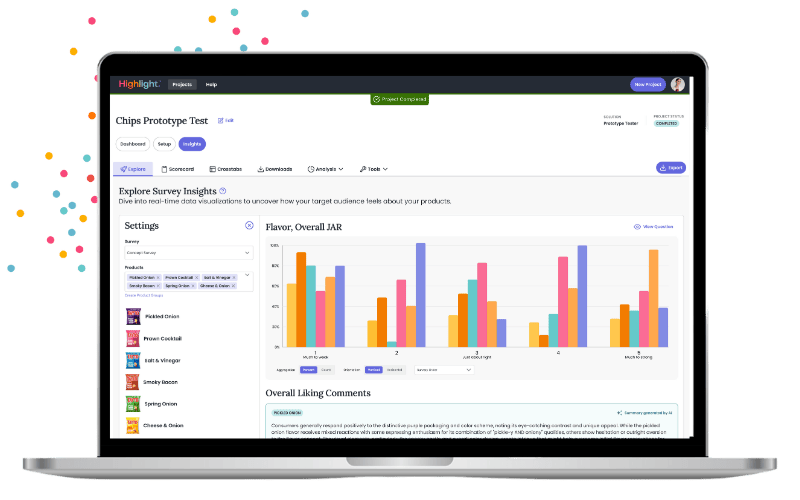As any product researcher or sensory scientist knows, taste tests and sensory tests are essential in the product development process. They help to ensure that products meet consumer expectations and preferences, and can even uncover previously unknown needs. But what exactly is involved in a taste or sensory test? And how can these tests be used to improve products? Read on to find out.
Taste testing and sensory testing in product development
Taste and sensory tests are essential parts of product development for consumer packaged goods. Research conducted through this type of testing helps companies better understand consumer preferences for flavor, texture, color, and more when it comes to their products. By focusing on consumer feedback during the product development process, companies can create products that best match consumer needs and expectations, ensuring repeat purchases by their consumers. Sensory testing is invaluable in helping brands design products that are successful in the marketplace.
The importance of having a diverse panel of testers with different preferences
Having a diverse panel of testers with different preferences is essential when conducting sensory and taste testing research, as preferences can vary significantly across demographics and target audiences. For example, preferences in teenagers may be markedly different from those of older adults, so having multiple generations represented among the test group provides an objective way to measure preferences more accurately. Gaining insight into these preferences helps organizations better understand their target consumers for targeted product development and marketing strategies. Ultimately, a panel of testers that captures the preferences across diverse demographics helps ensure success in delivering products and services that reflect customer needs.
How taste and sensory testing can help improve the quality of products
By conducting in-home user usage tests, companies can gain insight into how consumers interact with their products in real-world scenarios. Respondents in in-home usage test trials complete questionnaires or surveys, allowing researchers to see how certain product attributes such as flavor, texture, or scent are perceived in a home environment - the perfect setting to understand how their product fits into a wider range of day-to-day activities. With this data in hand, brands can then make informed decisions about improvements that enhance their product's overall quality and performance. In doing so, not only does taste and sensory testing help ensure that consumers are receiving the best possible experience but it also contributes to greater brand loyalty as customers recognize the extra effort that has gone in ensuring they have access to premium products.
Tips on how to conduct effective taste and sensory tests
Conducting in-home taste and sensory tests can be a tricky endeavor, so it's important to create an organized and effective plan in order to optimize the testing process. Utilizing an in-home research environment in combination with online surveys is an optimal way to capture consumer responses in order to find out how they responded to the product in question since it brings in key factors such as shopping habits, food preparation, and dining experience. Additionally, choose panelists that match your target market’s demographic in order to make sure the feedback provided is truly representative of the consumers you are trying to reach. Often, these tests can be blinded for unbiased feedback with a wide array of both qualitative and quantitative sensory testing responses. Solutions like Highlight's in-home product testing platform cover all the logistics of repackaging and blinding while offering qualitative and quantitative questions, and photo and video feedback.
Products that benefit from taste tests and sensory tests
Some of the most recognizable products around have benefitted from taste and sensory testing. Many food and beverage producers rely on testers to perfect the flavor of their products, with popular items such as craft beer, artisanal candy, and premium coffee hitting shelves thanks to careful evaluations. In addition, cosmetics companies often use testers to assess all of their products and adjust them for optimum customer satisfaction. Finally, the packaging is increasingly tested for human perception in terms of design and ease of use, so that customers can enjoy intuitive interactions with their purchases. Companies are always looking for new ways to refine the effectiveness of these taste and sensory tests, ensuring that what appears on store shelves is sure to delight consumers.
This important practice allows big companies to cultivate consumer experiences, from the flavor profile of popular snacks to how fragrance is delivered through a perfume bottle. Taste and sensory feedback can inform an organization's decision-making process and ability to stay competitive in today's market.
These tests provide data points for product development teams like information on which flavors are trending and consumer reactions that may require adjustment in formula or packaging design. Ultimately, taste and sensory testing is an essential tool for understanding consumer preferences and delivering products consumers enjoy.
By involving a panel of testers with different preferences, companies can identify potential problems early on and make necessary changes to improve the quality of their products. Additionally, taste and sensory tests can help improve communication between developers and consumers, leading to more satisfied customers.


![[Image] Highlight team Holiday party 2022](https://www.letshighlight.com/hs-fs/hubfs/%5BImage%5D%20Highlight%20team%20Holiday%20party%202022%20.png?width=1920&height=1080&name=%5BImage%5D%20Highlight%20team%20Holiday%20party%202022%20.png)


